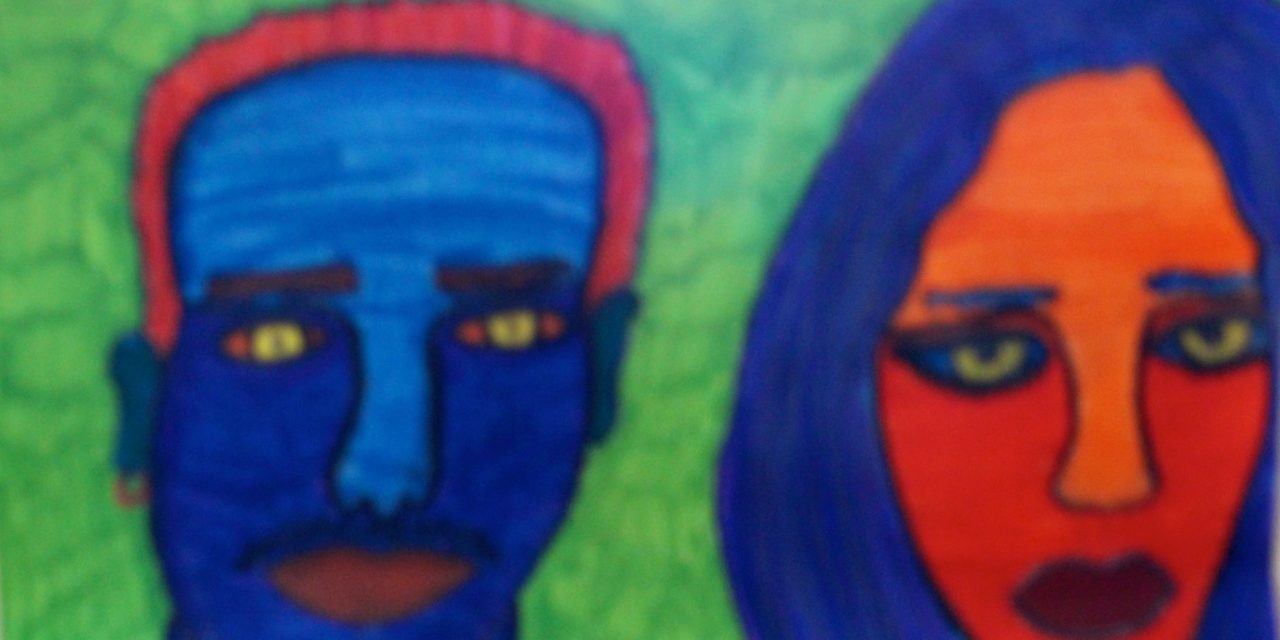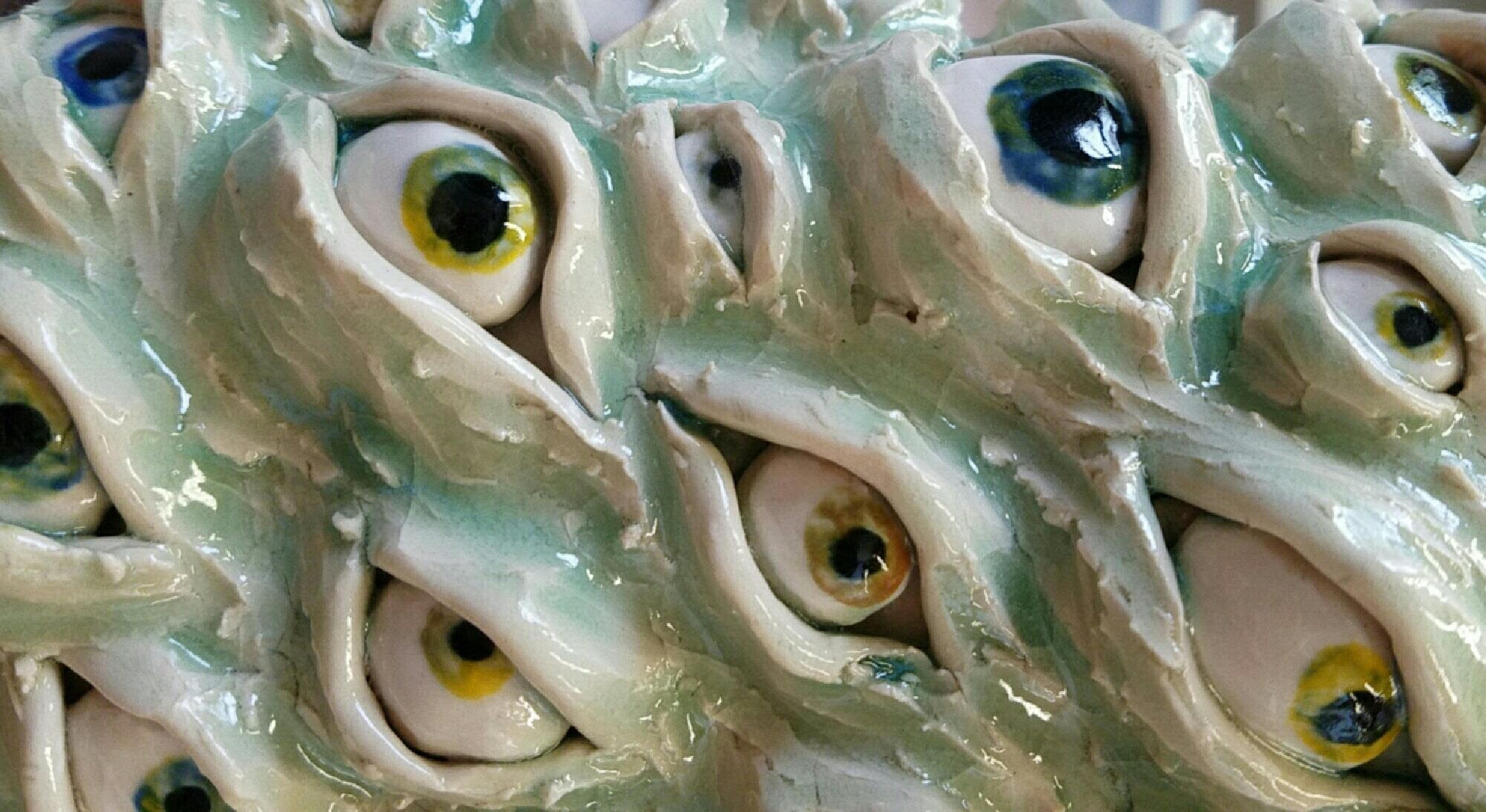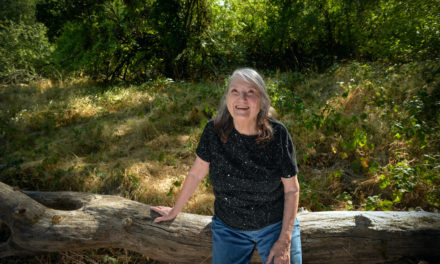(Above: Using her art helps Sammy Bollag express the dualities of transgender transition in her own life.)
By Randi Bjornstad

An early childhood self-portrait by the young Sam Bollag
Sammy Bollag has been an artist since preschool, and now as a transgender woman, being able to explore her life, feelings and transition through drawing and painting has become even more important.
One of her earliest self-portraits — only she was Sam then instead of Sammy — still hangs on a wall in her parents’ home. Then, it appeared to be a smiling child with short brown hair, wearing a harlequin-like outfit in green and blue print. Now, it’s easy to wonder, looking at the figure’s long eyelashes, pinked-in lips and feminine stance, if little Sam already had an inkling that gender is not necessarily fixed at birth.
“My parents have art everywhere in their house — it feels like being in a museum — so I feel very honored that they put my little picture up and left it up,” Bollag said during a recent interview in her small duplex apartment with walls covered by her own art.
“I don’t have much memory of my earliest childhood, but I remember that my first consciousness that I was a girl was probably when I was 8 or 9,” she said. “I do remember playing with my sister and how we dressed up in my mom’s clothes when I was pretty young.”

A recent self-portrait by the now-adult Sammy Bollag
Now 29, Bollag said she lived her life as a young man until two years ago, when she couldn’t maintain the fiction any longer.
“I had decided that I wasn’t going to come out until after my parents had both died, but I just couldn’t wait that long to be myself,” she said. “I waited until I was very sure of what I needed to do and felt I had enough confidence in my ability to live my life without my parents if they rejected me.”

Some of Bollag’s art draws on her feelings of alienation
She remembers applying colorful fingernail polish and going into the restaurant her parents own, “and my dad got all upset, but he has become much more accepting,” she said. “I know it’s been really hard for my mom too, but it was something I just had to do, to be honest to myself.”
Art always has been an important part of her life, but her approach to it has changed “100 percent” since she began her transition, Bollag said.
“I feel more able now not to have to conform to what other people do, to experiment with subjects and body shapes, and even creatures,” she said. “I want to do really surreal faces and explore relationships, like male and female faces that are two people but really one.”
The painters who have influenced her approach the most include pop/street and neoexpressionists Andy Warhol, Keith Haring, and Jean-Michel Basquiat as well as more mainstream names such as Pablo Picasso, Pierre-Auguste Renoir and Vincent Van Gogh. But Bollag says she’s also always been surrounded by artists in her own family.
“My dad does his artistry with food at the restaurant, and my grandmother on my mom’s side is a talented painter — she does oils, which I haven’t been able to master yet — and she’s also a creative clothing maker. My mom also is very artistic, with a great sense of style and color.”

Sammy Bollag; photo by Randi Bjornstad
Tall and slender, with dark hair and a smouldering gaze, Bollag started her hormone regimen 18 months ago, and she’s gradually becoming more and more comfortable with her ability to navigate socially as female. Even so, she still experiences setbacks that leave her emotionally fraught when she encounters someone who does not react to her immediately as a woman.
The conflict is apparent in her art.
“I do mostly people,” she said, “although I have gotten into some landscapes more recently,” pointing to one that she says describes her feelings when she feels contented with her life and her progress.
“I also have gotten more into exploring things that are even extraterrestrial, maybe because I still feel somewhat alien — not like other people — at times.”
She’s also noticed that she tends to create drawings these days with two objects or figures portrayed in colors inverted from one to the other.

A painting she calls “Heaven” recalls Bollag’s moments of satisfaction with her life
“I’m not exactly sure what that means, but I’m sure it has something to do with my transition,” she said.
Her recent art has been mostly ink drawings, often with Sharpie markers on paper or sometimes on the back of cigarette or other cartons that she retrieves from her job at a corner grocery store. Occasionally, she uses nail polish to add a third dimension to her work.
“That’s mostly out of necessity, because it’s pretty much what I can afford right now,” Bollag acknowledged. “I was fired from one job after I came out, and that was hard financially and emotionally. But now I’m working again, at a place I enjoy and where I seem to be accepted.”
She creates as often as she can, as the spirit moves her, “and I don’t necessarily think my art is very great,” Bollag said. “But I believe it’s a true expression of myself, so I find value in that.
“As artists, I think that’s the most important thing we can do.”

Drawing faces and landscapes each helps Sammy Bollag express progress in her transition in different ways








